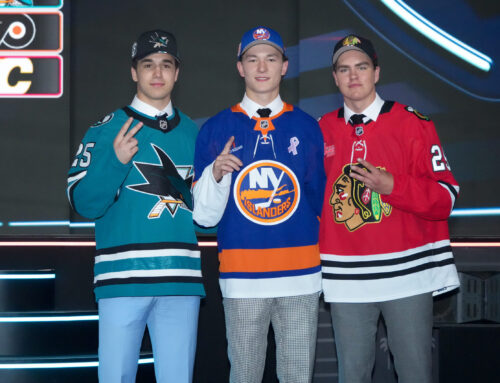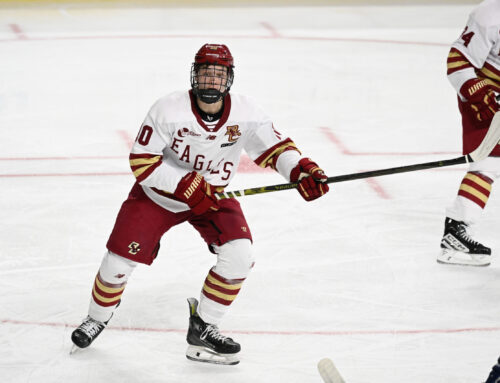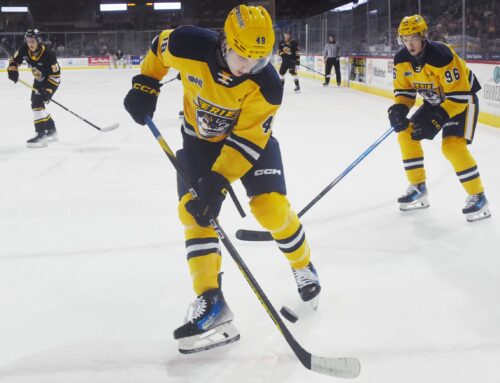
You have to be patient with prospects, and that's especially true with goalies and defencemen. Forwards are most likely to jump into the NHL at a young age and have a fantasy impact, but there's a certain breed of forward that requires just as much patience as goalies and defensemen: power forwards.
Not only do they take longer to reach the NHL, they usually take longer to reach their upside. Pittsburgh Penguins prospect Eric Tangradi – No. 26 on Dobber's list of top prospects — is a classic example of that.
As a 17-year-old, Tangradi was a rookie in the OHL and struggled to make adjustments and earn ice time. Still, his size and flashes of latent skill were enough to attract the interest of some scouts. By the time the playoffs rolled around, however, everybody was taking notice.
After putting up just 20 points (five goals and 15 assists) in 65 regular season games, Tangradi nearly matched that in 15 playoff games (eight goals and nine assists).
On the strength of that playoff performance, Anaheim made the six-foot-four, 225-pound Philadelphia native a second-round pick (42nd overall).
As an 18-year-old the following season, Tangradi showed his playoff performance the previous spring was not a fluke and that he had made huge strides in his development. With 60 points in 56 games (24 goals, 36 assists), he had arrived as a prospect and became a poster boy for projectability.
Projecting is what scouts do when they watch players at the age of 17. They don't look at a player at that age and wonder if the kid can play for their team at that age or in a year or two. What they're wondering is what that player will be in five to 10 years. They are projecting how much that player will develop in the future and deciding if that player will make an impact in the NHL.
Often, when they are doing this, they are not looking at the stats that a player is putting up in junior. Even in the regular season of his draft year, Tangradi drew the interest of scouts.
What they saw was a big forward with good hands and finish around the net. They knew his skating needed improvement, but improvement could be made and even still – it wasn't a major drawback.
As a rookie, he became Belleville's best forward in the playoffs. He was a force on every shift, creating a buzz by playing simple hockey, going to the net and looking for rebounds. He was difficult to contain down low and showed an amazing ability to cycle the puck,
In his final season of junior, Tangradi led the OHL in scoring for a while and got to play for Team USA at the world junior tournament. That latter experience he'd rather forget though as he didn't produce up to his ability and sparked some controversy in a game against Canada.
Still, to most fantasy GMs, Tangradi was below the radar. Then, he got traded to Pittsburgh with Chris Kunitz for Ryan Whitney and, all of the sudden he's a possible future linemate for Sidney Crosby or Evgeni Malkin.
Since the trade, it's been a tough road for Tangradi. He suffered a hand injury (severed tendon) in last spring's OHL playoffs and needed surgery. His summer was a painful one as he rehabilitated the injury. He needed a follow up procedure to remove some scar tissue and then suffered a shoulder injury last fall that hampered his adjustment to the AHL.
As he did in the OHL, Tangradi struggled to produce at first in the AHL, but has recently started putting more points up on the board.
He has nine goals and six assists for 15 points in 32 games this season. But, since Dec. 28, he has scored four goals and three assists for seven points in eight games.
I own Tangradi in my keeper league and have received some interest in him from rebuilding GMs. He was high on a lot of draft lists last year after his trade to Pittsburgh. If you own him, or were interested in him, you shouldn't let his slow start discourage you.
He was a buy-low candidate, but is showing now that his adjustment to a new league and a different level of hockey takes time. A pattern is developing so expect it again when he makes it to the NHL. If you're patient with Tangradi, it will pay off.
Despite Pittsburgh's winger situation, they have shown that they won't rush Tangradi. I expect him to stay in the AHL this year. With continued development this season and a strong camp next year, he could arrive as early as 2010-11. If he shows chemistry with Crosby or Malkin, he'll obviously produce more than most young power forwards would. He'll be spotty at first, but once he settles in, he may be exactly what Pittsburgh needs.
Upside: 30-50-80.





 EDM
EDM TOR
TOR PIT
PIT VAN
VAN FLA
FLA MIN
MIN DET
DET COL
COL DAL
DAL
